🍁🍂🌄
🍁🍂🌄

More Posts from Monstrous-mind and Others
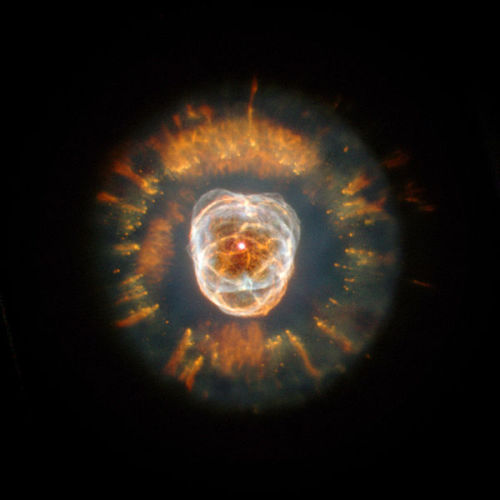
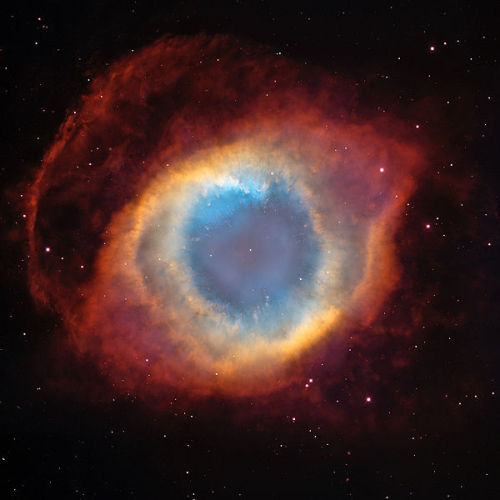
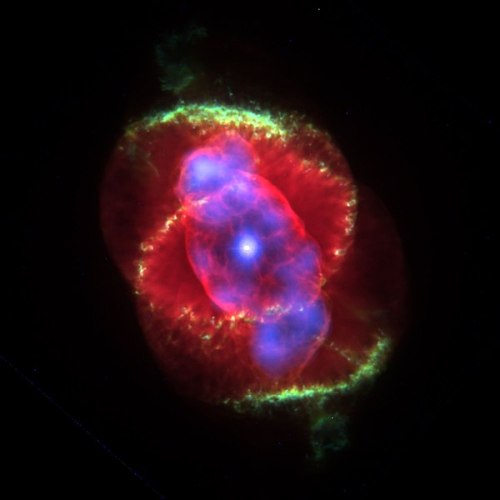




Planetary nebula
A planetary nebula, abbreviated as PN or plural PNe, is a kind of emission nebula consisting of an expanding, glowing shell of ionized gas ejected from red giant stars late in their lives. The word “nebula” is Latin for mist or cloud, and the term “planetary nebula” is a misnomer that originated in the 1780s with astronomer William Herschel because, when viewed through his telescope, these objects resemble the rounded shapes of planets. Herschel’s name for these objects was popularly adopted and has not been changed. They are a relatively short-lived phenomenon, lasting a few tens of thousands of years, compared to a typical stellar lifetime of several billion years.
Most planetary nebulae form at the end of the star’s life, during the red giant phase, when the outer layers of the star are expelled by strong stellar winds. After most of the red giant’s atmosphere is dissipated, the ultraviolet radiation of the hot luminous core, called a planetary nebula nucleus (PNN), ionizes the ejected material. Absorbed ultraviolet light energises the shell of nebulous gas around the central star, causing it to appear as a brightly coloured planetary nebula.
Planetary nebulae likely play a crucial role in the chemical evolution of the Milky Way by expelling elements to the interstellar medium from stars where those elements were created. Planetary nebulae are observed in more distant galaxies, yielding useful information about their chemical abundances.
Stars greater than 8 solar masses (M⊙) will likely end their lives in dramatic supernovae explosions, while planetary nebulae seemingly only occur at the end of the lives of intermediate and low mass stars between 0.8 M⊙ to 8.0 M⊙.
source
images: NASA/ESA, Hubble
String Theory
String theory is a fascinating physical model in which all particles are replaced by one-dimensional objects known as strings. This theory says that we live in more than four dimensions, but we can not perceive them.
String theory, is a complete theory and unites quantum physics with Einstein’s general relativity.

On distance scales larger than the string scale, a string looks just like an ordinary particle, with its mass, charge, and other properties determined by the vibrational state of the string. In string theory, one of the many vibrational states of the string corresponds to the graviton, a quantum mechanical particle that carries gravitational force. Thus string theory is a theory of quantum gravity.

According to string theory, the reason we can not observe these dimensions is because they are very small and compact (smaller than the plank length 10 −35)


Compactification is one way of modifying the number of dimensions in a physical theory. In compactification, some of the extra dimensions are assumed to “close up” on themselves to form circles. In the limit where these curled up dimensions become very small, one obtains a theory in which spacetime has effectively a lower number of dimensions. A standard analogy for this is to consider a multidimensional object such as a garden hose. If the hose is viewed from a sufficient distance, it appears to have only one dimension, its length. However, as one approaches the hose, one discovers that it contains a second dimension, its circumference. Thus, an ant crawling on the surface of the hose would move in two dimensions.

Compactification can be used to construct models in which spacetime is effectively four-dimensional. However, not every way of compactifying the extra dimensions produces a model with the right properties to describe nature. In a viable model of particle physics, the compact extra dimensions must be shaped like a Calabi–Yau manifold

Another approach to reducing the number of dimensions is the so-called brane-world scenario. In this approach, physicists assume that the observable universe is a four-dimensional subspace of a higher dimensional space. In such models, the force-carrying bosons of particle physics arise from open strings with endpoints attached to the four-dimensional subspace, while gravity arises from closed strings propagating through the larger ambient space. This idea plays an important role in attempts to develop models of real world physics based on string theory, and it provides a natural explanation for the weakness of gravity compared to the other fundamental forces

One notable feature of string theories is that these theories require extra dimensions of spacetime for their mathematical consistency. In bosonic string theory, spacetime is 26-dimensional, while in superstring theory it is 10-dimensional, and in M-theory it is 11-dimensional. In order to describe real physical phenomena using string theory, one must therefore imagine scenarios in which these extra dimensions would not be observed in experiments.

The original version of string theory was bosonic string theory, but this version described only bosons, a class of particles which transmit forces between the matter particles, or fermions. Bosonic string theory was eventually superseded by theories called superstring theories. These theories describe both bosons and fermions, and they incorporate a theoretical idea called supersymmetry.

This is a mathematical relation that exists in certain physical theories between the bosons and fermions. In theories with supersymmetry, each boson has a counterpart which is a fermion, and vice versa.

There are several versions of superstring theory: type I, type IIA, type IIB, and two flavors of heterotic string theory (SO(32) and E8×E8). The different theories allow different types of strings, and the particles that arise at low energies exhibit different symmetries. For example, the type I theory includes both open strings (which are segments with endpoints) and closed strings (which form closed loops), while types IIA, IIB and heterotic include only closed strings.

Branes
In string theory and other related theories, a brane is a physical object that generalizes the notion of a point particle to higher dimensions. For instance, a point particle can be viewed as a brane of dimension zero, while a string can be viewed as a brane of dimension one. It is also possible to consider higher-dimensional branes. In dimension p, these are called p-branes. The word brane comes from the word “membrane” which refers to a two-dimensional brane
In string theory, D-branes are an important class of branes that arise when one considers open strings

D-branes are typically classified by their spatial dimension, which is indicated by a number written after the D. A D0-brane is a single point, a D1-brane is a line (sometimes called a “D-string”), a D2-brane is a plane, and a D25-brane fills the highest-dimensional space considered in bosonic string theory. There are also instantonic D(–1)-branes, which are localized in both space and time.
Duality
A striking fact about string theory is that the different versions of the theory prove to be highly non-trivial in relation. One of the relationships that exist between different theories is called S-duality. This is a relationship that says that a collection of interacting particles in a theory may in some cases be viewed as a collection of weak interacting particles in a completely different theory. Approximately, a collection of particles is said to interact strongly if they combine and deteriorate frequently and interact poorly if they do so infrequently. The type I string theory turns out to be equivalent by S-duality to the heterotic string theory SO (32). Likewise, type IIB string theory is related to itself in a non-trivial way by S-duality

Another relationship between different string theories is T-duality. Here one considers strings propagating around a circular extra dimension. T-duality states that a string propagating around a circle of radius R is equivalent to a string propagating around a circle of radius 1/R in the sense that all observable quantities in one description are identified with quantities in the dual description. For example, a string has momentum as it propagates around a circle, and it can also wind around the circle one or more times. The number of times the string winds around a circle is called the winding number. If a string has momentum p and winding number n in one description, it will have momentum n and winding number p in the dual description. For example, type IIA string theory is equivalent to type IIB string theory via T-duality, and the two versions of heterotic string theory are also related by T-duality.

Black holes
In general relativity, a black hole is defined as a region of spacetime in which the gravitational field is so strong that no particle or radiation can escape. In the currently accepted models of stellar evolution, black holes are thought to arise when massive stars undergo gravitational collapse, and many galaxies are thought to contain supermassive black holes at their centers.

Black holes are also important for theoretical reasons, as they present profound challenges for theorists attempting to understand the quantum aspects of gravity. String theory has proved to be an important tool for investigating the theoretical properties of black holes because it provides a framework in which theorists can study their thermodynamics.

The big bang theory doesn’t offer any explanation for what started the original expansion of the universe. This is a major theoretical question for cosmologists, and many are applying the concepts of string theory in attempts to answer it. One controversial conjecture is a cyclic universe model called the ekpyrotic universe theory, which suggests that our own universe is the result of branes colliding with each other.
Some things that string theory could explain: Neutrinos would have to have mass (minimum), Decay of Proton, New fields of force (short and long range) defined by some forms of calabi-yau, Explanations for Dark Matter.
sources: x, x, x, x, x, x

String theory is a very complex and broad area, so this post is only a summary. To better understand, I suggest you read Brian Greene’s books: The Elegant Universe and The Fabric of the Cosmo.

Puraten10 on Instagram
🍁🍂🎃🌄

Wistfully Country on Pinterest.
🍁🍂🌄

Autumn sky
🔭🌃🌌🐈

Located over 50 million light years away, the large, distorted spiral NGC 1532 is seen locked in a gravitational struggle with dwarf galaxy NGC 1531 (right of center), a struggle the smaller galaxy will eventually lose.
Image Credit: Michel Meunier, Laurent Bernasconi, Janus Team
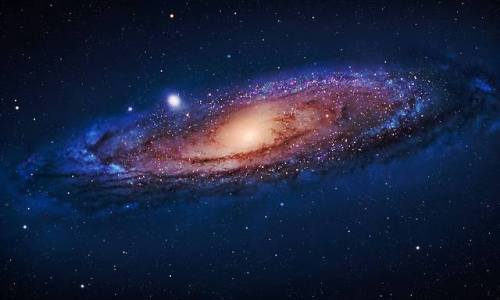
The Milky Way’s long-lost sibling finally found
Scientists at the University of Michigan have deduced that the Andromeda galaxy, our closest large galactic neighbor, shredded and cannibalized a massive galaxy two billion years ago.
Even though it was mostly shredded, this massive galaxy left behind a rich trail of evidence: an almost invisible halo of stars larger than the Andromeda galaxy itself, an elusive stream of stars and a separate enigmatic compact galaxy, M32. Discovering and studying this decimated galaxy will help astronomers understand how disk galaxies like the Milky Way evolve and survive large mergers.
This disrupted galaxy, named M32p, was the third-largest member of the Local Group of galaxies, after the Milky Way and Andromeda galaxies. Using computer models, Richard D'Souza and Eric Bell of the University of Michigan’s Department of Astronomy were able to piece together this evidence, revealing this long-lost sibling of the Milky Way. Their findings were published in Nature Astronomy.
source
🔭🌌🌃

Saturn - GREEN-BLUE-VIOLET - August 11 1981 Credit: NASA/JPL-Caltech/Kevin M. Gill
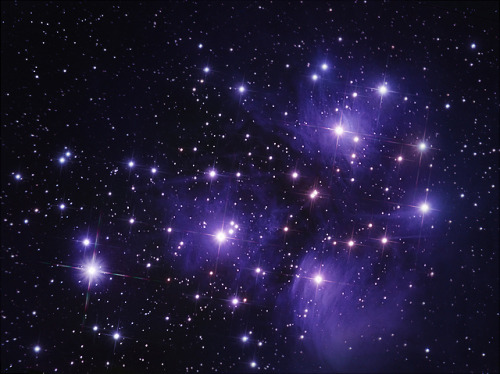
Pleiades by Chuck Manges
-
 halloweeen reblogged this · 2 weeks ago
halloweeen reblogged this · 2 weeks ago -
 crookedpvth liked this · 2 weeks ago
crookedpvth liked this · 2 weeks ago -
 nostalgichalloween reblogged this · 2 months ago
nostalgichalloween reblogged this · 2 months ago -
 nostalgichalloween reblogged this · 3 months ago
nostalgichalloween reblogged this · 3 months ago -
 scoobydootaz77 liked this · 4 months ago
scoobydootaz77 liked this · 4 months ago -
 herecometheholidays reblogged this · 4 months ago
herecometheholidays reblogged this · 4 months ago -
 rikareena liked this · 4 months ago
rikareena liked this · 4 months ago -
 aaseevalbourgeidunnkamilleblog liked this · 4 months ago
aaseevalbourgeidunnkamilleblog liked this · 4 months ago -
 maebaby1 liked this · 4 months ago
maebaby1 liked this · 4 months ago -
 gracieness reblogged this · 4 months ago
gracieness reblogged this · 4 months ago -
 autumn-n-acorns reblogged this · 4 months ago
autumn-n-acorns reblogged this · 4 months ago -
 yunbohei liked this · 5 months ago
yunbohei liked this · 5 months ago -
 cat-mermaid reblogged this · 5 months ago
cat-mermaid reblogged this · 5 months ago -
 zamashi reblogged this · 6 months ago
zamashi reblogged this · 6 months ago -
 yousawthewholeofthemoon reblogged this · 6 months ago
yousawthewholeofthemoon reblogged this · 6 months ago -
 blueridgemountainsmaiden reblogged this · 6 months ago
blueridgemountainsmaiden reblogged this · 6 months ago -
 annita89r9w4ukrqh liked this · 6 months ago
annita89r9w4ukrqh liked this · 6 months ago -
 againstpollutions liked this · 7 months ago
againstpollutions liked this · 7 months ago -
 thisisthebeatofmyblog reblogged this · 7 months ago
thisisthebeatofmyblog reblogged this · 7 months ago -
 rosethornblood liked this · 7 months ago
rosethornblood liked this · 7 months ago -
 echoguyy reblogged this · 7 months ago
echoguyy reblogged this · 7 months ago -
 moonlit-smile-778 reblogged this · 7 months ago
moonlit-smile-778 reblogged this · 7 months ago -
 moon-times reblogged this · 7 months ago
moon-times reblogged this · 7 months ago -
 shannybangbang reblogged this · 7 months ago
shannybangbang reblogged this · 7 months ago -
 kitkat203posts reblogged this · 7 months ago
kitkat203posts reblogged this · 7 months ago -
 nurtureinspire reblogged this · 7 months ago
nurtureinspire reblogged this · 7 months ago -
 eldenroots reblogged this · 7 months ago
eldenroots reblogged this · 7 months ago -
 ehlnofaey liked this · 7 months ago
ehlnofaey liked this · 7 months ago -
 bubblgobbo reblogged this · 7 months ago
bubblgobbo reblogged this · 7 months ago -
 leota-nexus liked this · 7 months ago
leota-nexus liked this · 7 months ago -
 dreamskug reblogged this · 7 months ago
dreamskug reblogged this · 7 months ago -
 dontworrywereallcats reblogged this · 7 months ago
dontworrywereallcats reblogged this · 7 months ago -
 samhaindream reblogged this · 7 months ago
samhaindream reblogged this · 7 months ago -
 lacroixisgoodstfu liked this · 7 months ago
lacroixisgoodstfu liked this · 7 months ago -
 naturesphinx reblogged this · 7 months ago
naturesphinx reblogged this · 7 months ago -
 unspokenmantra reblogged this · 7 months ago
unspokenmantra reblogged this · 7 months ago -
 unspokenmantra liked this · 7 months ago
unspokenmantra liked this · 7 months ago -
 into-ition reblogged this · 7 months ago
into-ition reblogged this · 7 months ago -
 wandering-cynic reblogged this · 7 months ago
wandering-cynic reblogged this · 7 months ago -
 lucidseduction reblogged this · 7 months ago
lucidseduction reblogged this · 7 months ago -
 gewoehnlicherstalker reblogged this · 7 months ago
gewoehnlicherstalker reblogged this · 7 months ago -
 crno-bog reblogged this · 7 months ago
crno-bog reblogged this · 7 months ago -
 crno-bog liked this · 7 months ago
crno-bog liked this · 7 months ago -
 13desdemona13 reblogged this · 7 months ago
13desdemona13 reblogged this · 7 months ago -
 wake-up-dead-2 reblogged this · 7 months ago
wake-up-dead-2 reblogged this · 7 months ago -
 dreamskug liked this · 7 months ago
dreamskug liked this · 7 months ago
My ambition is handicapped by laziness. -C. Bukowski Me gustan las personas desesperadas con mentes rotas y destinos rotos. Están llenos de sorpresas y explosiones. -C. Bukowski. I love cats. Born in the early 80's, raised in the 90's. I like Nature, Autumn, books, landscapes, cold days, cloudy Windy days, space, Science, Paleontology, Biology, Astronomy, History, Social Sciences, Drawing, spending the night watching at the stars, Rick & Morty. I'm a lazy ass.
222 posts
